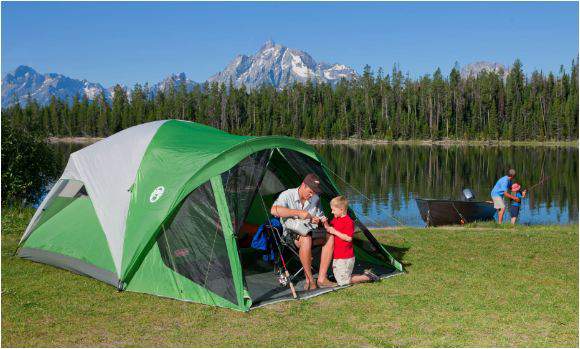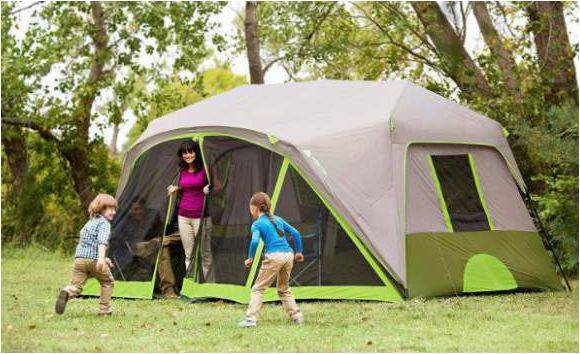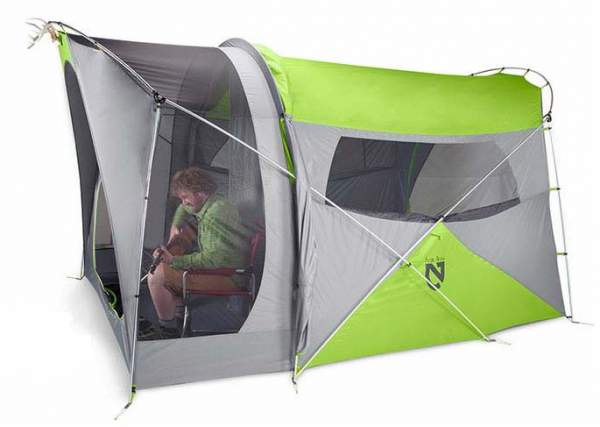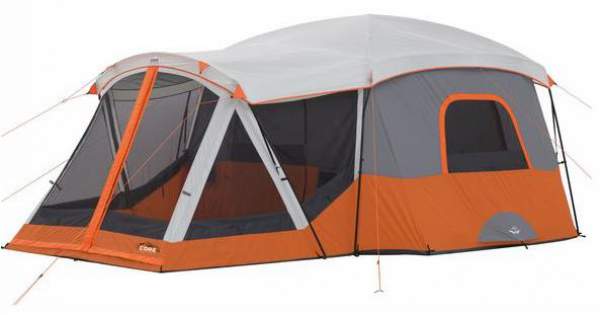The terms screen room and screened porch are frequently used in the description of family camping tents. So what is a screen room tent really? Keep reading, you will find the answer here.
In most cases, there isn’t a significant difference in how these two terms ‘screen room’ and ‘screened porch’ are used in the description of camping tents (but there are exceptions, see below). Sometimes, you will also see the phrase ‘screened tent’ used, so you have to guess if this is a screened porch or a screened room.
Anyhow, instead of getting into the semantics and the true meaning of these phrases, here I shall present what you can typically find in the tents on the market.
Differences with regards to the tent type
Regarding the overall tent construction, you will typically find the following cases:
- Dome tents with attached screen room (or screened porch).
- Cabin style tents with such a screened addition.
- Some more particular designs, for example with the screened area and a full cover fly.
- Freestanding and non-freestanding tents.
1. The dome tents with screen room, in general, offer less comfort because of their curved walls and relatively small headroom. Now, when you have a screen room added, it is usually an extended section of the main dome, and it follows the same geometry. So the floor area is increased, but such structures are typically lower than the tents from the same group, and they offer less comfort.
But such dome structures are also more aerodynamic and perform better in strong winds. They can even withstand some vertical pressure (e.g., from the snow), contrary to cabin tents. You can see a great example in the picture below, the Coleman Evanston 6 screened tent:

2. The cabin style tents with screen room are usually with the following features:
- much taller structures,
- with many windows,
- sometimes with multiple doors and multiple rooms,
- very livable in general.
Such tents are mainly for summer camping. So they have ceilings mainly mesh, covered by a minimal fly. The huge mesh areas imply that the warmth is not well preserved, this is why they are not so suitable for a cold environment.
Being very tall, such cabin tents are not the best design against strong winds, and this is one reason more to use them in very mild summer conditions.
The mentioned minimal fly is on purpose so that the views through large windows are not obstructed. But this also implies that they are never full-coverage so the protection is not complete, and they are very high above the ground, therefore unstable against the wind. So you realize what you have here – the comfort on the account of better protection.
But straight and vertical walls allow for using cots and bunk beds which will fit nicely against such walls. Such tents are very tall and pleasant with lots of volume and with the feeling of being at home.
Such cabin style tents are sometimes instant tents as well, so their setup is very easy and quick. This makes them perfect tools for people on some cross-country tours or when the camping place is changed frequently. Here is one great example of this type, the Ozark Trail 9-person instant cabin tent with screen room:

3. Other types with the rain fly. One nice example of this type is the NEMO Wagontop 6 Person Tent, a particular cabin-style freestanding tent where you have the screened vestibule area with a full coverage fly over it while the rest of the tent is a single-layer design. The picture below shows this tent without the fly which normally covers only the front screened area (the rest is waterproof itself):

4. The tents mentioned above can be either freestanding (fully or partly) or non-freestanding. So for example, the Nemo tent is freestanding, the Ozark Trail 9-Person Instant Cabin Tent is mainly freestanding except for the screen room part. The Coleman Evanston 6 tent is not freestanding.
Differences regarding the floor of the screened area
Regarding the screen room floor, you can have the following situations:
- Screen room with a floor. In this case, you can have the following sub-types:
- The screen area is yet another room with an extra feature, e.g., screened walls but they are with panels so fully protected, and it serves as the usual room for sleeping. Great examples of such tents are the Wenzel Klondike 8 tent, Nemo Wagontop 6, and CORE 11 person cabin tent shown in the picture below:
- The screen room is only for sitting and for equipment storage, with the fly above but the walls are without panels, so the area is not fully protected from the rain. You will see some holes in the floor to drain the eventual water out. One typical example of this type is the Coleman Evanston 6 screened tent. It is best to use such tents in dry areas without rain, so you can use the screen room as yet another sleeping room.
- Screen area without a floor. Some manufacturers use the word screen porch for such tents. Typical examples of this type are the Ozark Trail 9-Person Instant Cabin Tent and Ozark Trail 10 person tent with screen porch. Such a design has its good sides because this is an area for sitting and cooking and you will not be concerned about damaging the floor by chair legs. I have a separate list of tents with a screen porch where only tents without a floor in the screened area are included.
So which design is the best? I guess this is a matter of preference and needs. If the main tent is a large area then you do not need more floored area in the porch, so this can be your mudroom. Also, if you have no rain at all, you will be cooking outside so the screened room can be used as an additional sleeping room, and having the floor is an advantage.
So this was my short introduction into the camping tents with screen room and screen porch, I hope now you have a bit more clear picture of the terminology. There are many tents of this type in the site. All the examples of the tents mentioned above are described in detail in my separate reviews, so please follow the links to find out more. See also my list of best tents with a screen room.
Thank you for reading, please use the comment box below if you have any question or comment. Have a nice day.

Another favorite is conservatory sunroom porch designs. These are characterized by a unique roof design styled like the Victorian glasshouses of the 19th century.
Thank you, I do not remember seeing such an example. Wonder if they are protected from the rain, partly or completely.